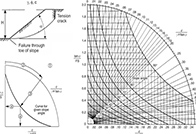Abstract:
Size limitations of geotechnical testing equipment often require that samples of coarse granular materials have to be scaled in order to be tested in the laboratory. Scaling implies a convenient modification of the particle size distribution (PSD) to reduce particle sizes. However, it is well known that particle size and shape may be correlated in nature, due to geological factors (as an example). By means of two-dimensional contact dynamics simulations, we analysed the effect of altering the size span on the shear strength of granular materials when particle size and shape are correlated. Two different systems were considered: one made of only circular particles, and the second made of size-shape correlated particles. By varying systematically the size span we observed that the resulting alteration of material strength is not due to the change in particle sizes. It results instead from the variation of the particle shapes induced by the modification of the PSD, when particle size and particle shape are correlated. This finding suggests that particle shape distribution is a higher order factor than PSD for the shear strength of granular materials. It also highlights the importance of particle shape quantification in soil classification and the case for its consideration in activities such as sampling, sub- sampling, and scaling of coarse materials for geotechnical testing.


20191128195834920.png)